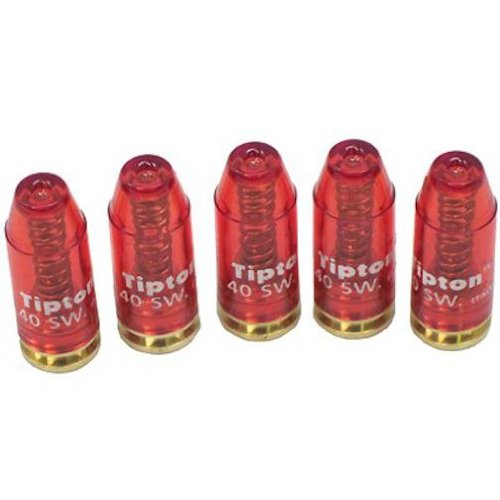In
tradition, the practice of dry
firing
was taboo, a cardinal sin. However, in every function test of a
military firearm – dry firing is part of the function test.
So
is it a myth passed down by generations, or based upon fact?
I
would like to settle this argument with logic and science …
The
answer, to make this article shorter, is it depends on the firearm.
Most modern firearms are not damaged, unless performed thousands of
times over and over when dry firing.
Gunsmiths usually have a set of
dummy rounds [snap
caps] in various calibers in order to test firearms by dry
firing; mostly out of respect for customers prized possessions.
One
thing is for sure and leading experts will tell you: rimfire
rifles and pistols should not be dry fired and if required in testing
mechanisms without live ammo, the dummy round is used.
Jeff
Johnson
wrote an article
back in July of 2011 that scientifically examined the argument. He
tested two rimfire firearms: a Henry
pump-action .22 rifle and a Browning
Buck Mark II .22 pistol. Note that both fire rimfire
ammunition.
He dry fired each 1,000 times and concluded:
In comparison photos of before-and-after 1,000 dry-fires of the Henry's chamber, slight marring of the breechface/barrel sleeve (where the firing pin strikes when dry-fired) was evident. The Browning's chamber showed no marring from the firing pin, but showed slight wear from the extractor repeatedly striking the rim of the extractor slot. Neither gun's firing pin exhibited visible damage. Indentations on fired cartridges from both guns were identical before and after dry-firing, indicating no functional damage. The Henry had two misfires out of 500 shots before dry-firing, and one misfire out of 500 shots after dry-firing. The Browning had no misfires before or after dry-firing; thus, I conclude no functional damage was incurred on either gun after dry-firing 1,000 times. However, because slight wear was identified after 1,000 dry-fires on both guns, it can be assumed that more dry-fires would cause additional wear that could eventually hamper functionality.
Manufacturers
provide instructions concerning dry firing …
- Ruger states that dry-firing their rimfire 10/22 rifles will not damage it.
- Henry Repeating Arms state the same – dry-fire all you want.
- Smith & Wesson states that their rimfire firearms should not be dry-fired.
- Browning states that dry-firing will not damage firing pins or chambers of its newer firearms.
Stronghold
Firearm Training website:
Dry firing is a very good way of practicing trigger control. Don't buy into the old mythe that dry firing damages guns. I have been dry firing consistently for years and tons of competition shooters do it. If you still are uncomfortable with it go spend $10 and pick up some snap caps for a piece of mind.
Dummy
rounds or snap caps are used by gunsmiths because they can safely
check firearms to ensure that semi-autos feed properly as well as
checking to see if the cartridge will bind. The cartridges are
weighted and balanced so it will feed and operate like a live round,
but adds a safety feature to ensure no accidents occur. They are not
cheap however, running from $7 to $16 for a pack of five. A pack of
308 Winchester snap caps in a package of two will run you about $10.
They are brightly colored, usually red, in order to clearly show they
are inert ammunition. The larger caliber rifle rounds are generally
more expensive and less rounds in packs.
If
you attend a gun show, always perform firearm courtesy by first
asking the owner permission to examine their firearm(s) and when
checking the actions, manually release the trigger without dry
firing. The reason is courtesy, not the fact that a firearm should
not be dry-fired. This is especially in the case of collector
firearms because older firearms usually have more brittle firing pins
than modern firearms, such as the CZ-52. And antique Smith &
Wesson firearms. Indeed, this is how the tradition of dry-firing
becoming taboo.
Using
snap caps not only helps one check feeding actions, but provides
peace of mind when worried about wearing out parts prematurely.
Snap
caps are also used for firearm training, concealed carry and draw,
and other such training procedures as a safety feature. They are the
same weight and dimensions of live ammunition, same reason gunsmiths
use them to check feeding and action functions without the danger of
live ammo.

I have some old military Mausers and as an old geezer I am well familiar with this old adage. Out of curiosity, I took the firing pin out of a Mauser and sooted the end with a candle.
ReplyDeleteI dry fired it once and then again a few times. It was clear the front shoulders at the base of the firing pin(the part that ultimately projects through the bolt face) were striking something though not hard.
Still, it would seem to me that at the very least, prolonged dry firing could increase the amount of firing pin protrusion and possibly cause an improperly heat treated pin to crack or break.
Jim from my wife's facebook account
Being a Mauser is older than an AR15/M16, your scenario holds true in respect to prolonged dry firing. However, if you consult the military manual dry firing is part of the functions check made each time the weapon is disassembled.
ReplyDelete